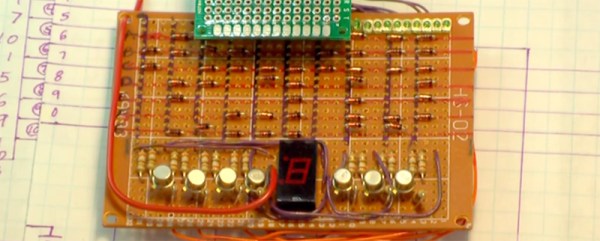While you’re not likely to see this technique used very much today, there’s a lot you can do with a 555, some logic chips, and a handful of diodes. [Fran] is here with a great example of using these simple parts to build a circuit that counts to zero, using parts you can probably find under your workbench.
[Fran] was inspired to build this diode counter from one of [Dave]’s Mailbags and [Colin Mitchell]’s 555 circuit book. The 555 is the standard component found in every parts drawer, but since we have tiny microcontrollers that cost the same as a 555, we’re not seeing the artistry of a simple timer chip and a few logic chips much these days.
This circuit began with a 555 attached to a 4017B decade counter. Simply by tying a few LEDs to the output of the 4017, [Fran] made a bunch of LEDs light up in sequence. Cool, but nothing unexpected. The real trick uses a few diodes and six LEDs to build a scanner – a line of LEDs that will blink from left to right, then right to left. Impressive, and with a little more circuitry it’s a Larson Scanner, as seen in Battlestar Galactica and Knight Rider.
The real trick for this technique comes when [Fran] pulls out a piece of protoboard, several dozen diodes, and seven old transistors to have a seven-segment display count from zero to nine. The 4017 simply counts out on ten pins, and each of these pins is wired to a bunch of diodes for each segment in the display. Add in a few resistors and a transistor, and [Fran] replicated what’s inside a seven-segment driver with discrete parts.
If counting to zero isn’t enough proof that you can do a whole lot with some diodes and logic chips, how about programming an Atari 2600 with one?
Video below.











